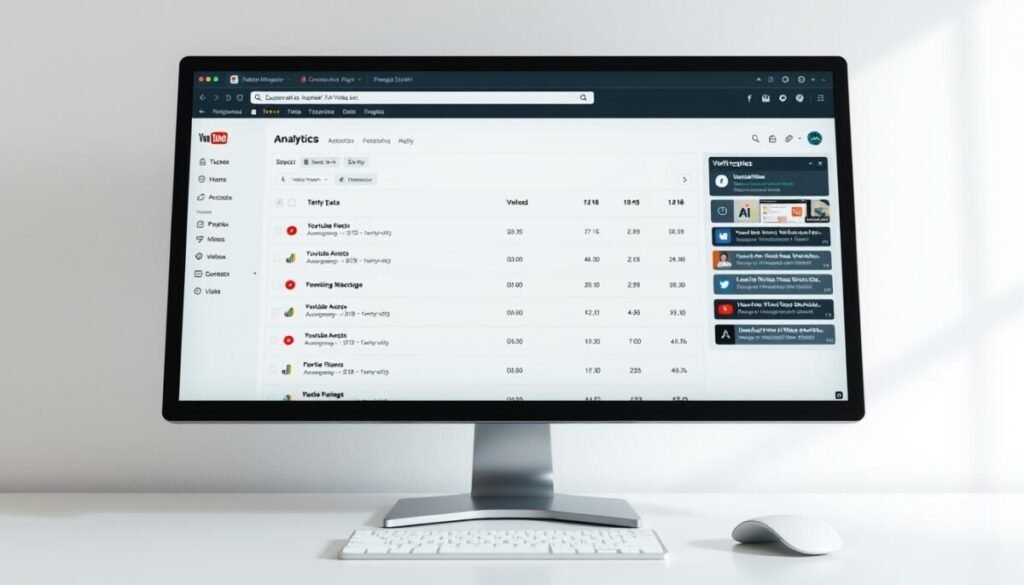What if your channel’s performance insights vanished right when you needed them most? Many creators face this exact problem. Metrics that should guide decisions suddenly freeze, leaving us guessing about our content’s impact.
We’ve all experienced that moment of confusion when numbers stop moving. While most metrics refresh within 48 hours, unexpected delays can stretch to three days. This gap between real-time engagement and finalized data often stems from verification processes that filter out artificial traffic.
Platforms prioritize accuracy over speed. Detailed reports require thorough checks to ensure valid viewer interactions. This protective measure helps maintain fair metrics but tests our patience during critical campaign evaluations.
Timing plays a crucial role here. Checking stats too frequently might show incomplete patterns, while waiting too long could mean missing optimization windows. We’ll break down how to strategically align your review schedule with update cycles for maximum clarity.
Key Takeaways
- Metrics typically finalize within 48 hours but may take up to 72
- Verification systems delay data to filter invalid interactions
- Real-time stats only cover basic metrics like view counts
- Frequent checks might display incomplete information
- Align analysis sessions with platform update patterns
Understanding the YouTube Analytics Update Cycle
Two clocks govern how we measure success. The platform uses instant snapshots and verified reports to balance speed with accuracy. This dual approach helps creators track trends while maintaining reliable metrics.
Instant Feedback vs Verified Reports
Real-time stats show immediate activity. View counts refresh every few seconds, revealing how content performs during launches or trending moments. These quick updates help us spot viral patterns early.
Most metrics need deeper validation. Systems cross-check interactions for 48-72 hours to filter artificial engagement. This process ensures watch time and audience retention figures reflect genuine interest.
| Metric Type | Update Speed | Key Measurements |
|---|---|---|
| Live Tracking | Seconds | Views, Traffic Sources |
| Verified Data | 2-3 Days | Watch Time, Demographics |
Timezone Impact on Refresh Rates
All updates sync with Pacific Time. This means new numbers arrive late at night for East Coast creators. West Coast teams see changes earlier in their evenings.
Global users face bigger gaps. A Tokyo-based creator might notice updates during lunch hours. Planning check-ins around these cycles prevents unnecessary concern over delayed numbers.
Troubleshooting YouTube analytics not updating

Why do our metrics sometimes freeze mid-update? Platforms implement protective systems to maintain data accuracy. These safeguards ensure reported numbers reflect genuine audience behavior rather than manipulated stats.
Verification Delays and Bot Prevention Measures
View counts often pause at specific thresholds like 300 interactions. This freeze allows systems to scan for artificial engagement from bots or duplicate users. While frustrating, this process protects our channel’s credibility by filtering invalid traffic.
Most delays resolve within three days. During this period, platforms cross-reference IP addresses, watch durations, and interaction patterns. Valid views get counted once confirmed, while suspicious activity gets discarded silently.
When to Revisit Your Analytics Data
Wait 72 hours before investigating discrepancies. Constant dashboard refreshes won’t speed up verification but might skew our perception of content performance. Track timestamps for each metric freeze to identify patterns.
Persistent issues beyond four days require action. Document specific details like affected videos and missing metrics before contacting support. This approach helps technical teams pinpoint problems faster. When you reach out for assistance, mentioning specific problems such as “youtube error 503 upload issues” can streamline the troubleshooting process. Providing clear examples will enable support representatives to address your concerns more effectively. Timely communication can lead to quicker resolutions and ensure your content is up and running without unnecessary delays. When reaching out to support, be clear about the urgency of the matter to ensure it receives prompt attention. This thorough documentation is particularly important for complex situations like resolving YouTube error 503 issues, as it enables support teams to provide more targeted assistance. Additionally, following up regularly can keep the process moving forward and help maintain accountability. Providing screenshots and error messages can significantly enhance the support process. When you reach out, be clear about the urgency of your situation, particularly if you need to troubleshoot YouTube community tab issues. This ensures that your request receives the appropriate attention and helps speed up the resolution.
- Create timestamped screenshots of stalled numbers
- Compare delayed metrics across multiple videos
- Check community forums for widespread issues
Navigating YouTube Studio for Accurate Insights

Mastering our channel’s performance starts with the platform’s built-in tool. Since 2021, this exclusive resource became our truth source for metrics after Google’s integration ended. Four dashboard sections hold the keys to understanding content impact.
Accessing Channel Metrics and Reports
The Overview page delivers immediate snapshots. We track total views, watch hours, and subscriber changes here. Top-performing videos and real-time activity appear for channels meeting data thresholds.
Our discovery patterns live in the Reach section. This area shows how many impressions our thumbnails generate and which traffic sources drive viewer visits. Click-through rates reveal what makes audiences stop scrolling.
| Section | Key Metrics | Optimization Use |
|---|---|---|
| Engagement | Watch hours, Avg. duration | Content length adjustments |
| Audience | Returning vs new viewers | Content scheduling |
Interpreting Engagement and Audience Tabs
The Engagement page answers what people actually watch. We analyze retention graphs to pinpoint where viewers disengage. This informs editing choices and pacing improvements.
Demographic breakdowns in the Audience section shape marketing strategies. Age ranges, geographic locations, and device preferences help tailor content. We spot trends like commute-time viewing spikes for weekday uploads.
Advanced filters let us compare metrics across dates or content types. This reveals whether tutorial videos outperform vlogs in specific regions – crucial intel for channel analytics refinement.
Optimizing Content and Promotion to Enhance Analytics Data

Transform raw views into meaningful growth by aligning content with viewer search habits. Strategic optimization turns casual clicks into measurable engagement, creating a feedback loop that sharpens both our creative output and performance tracking.
Leveraging SEO Strategies for Better Visibility
Our research starts with identifying high-value terms that match audience search patterns. Tools like Google Trends reveal what questions viewers ask about our topics. We weave these phrases naturally into titles and descriptions without sacrificing readability.
The platform’s algorithm prioritizes content that keeps viewers watching. We structure videos with clear sections and pacing that matches audience attention spans. This approach boosts retention rates – a key signal for search rankings.
Enhancing Thumbnails, Metadata, and User Engagement
Thumbnails act as visual headlines. We test combinations of bold text, contrasting colors, and expressive facial cues. Top-performing designs immediately communicate the video’s value while standing out in crowded feeds.
Three elements make metadata work harder:
- Precision tags: 5-7 specific phrases matching search intent
- Description depth: First 150 characters packed with keywords
- Guideline compliance: Avoiding restricted topics that trigger view suppression
We monitor how changes affect traffic sources and click-through rates. This data reveals which optimizations actually move the needle versus those that simply look good on paper.
Wrapping Up Our Insights and Next Steps
Our journey through data tracking patterns reveals a clear path forward. We now prioritize structured review sessions every 48-72 hours rather than daily checks. This rhythm aligns with platform verification cycles while protecting us from skewed interpretations.
Three practices will transform how we use insights. First, scheduled analysis prevents reactionary decisions based on incomplete numbers. Second, documenting discrepancies helps spot systemic issues faster. Third, blending SEO tactics with audience behavior patterns creates self-improving content strategies.
We’re building workflows where channel growth and data accuracy reinforce each other. Our next phase focuses on setting measurable goals using the platform’s advanced tools. Regular audits of viewer demographics and traffic sources will sharpen our marketing approaches.
Time management remains crucial. We allocate specific windows for metric reviews, freeing hours for creative production. This balance ensures our content quality drives sustainable reach rather than becoming overshadowed by constant number-crunching.



![Best Essay Writing AI [Free Essay Writing AI]](https://onlinetoolguides.com/wp-content/uploads/2022/03/1-AI-Writing-Assistant.jpg)